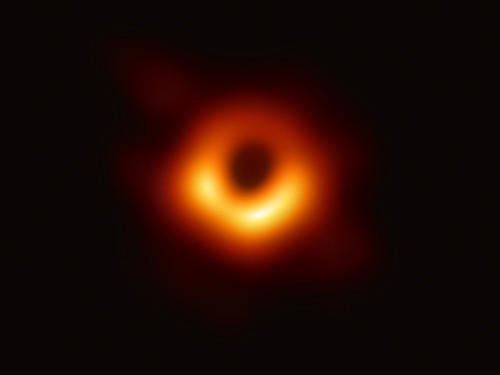The NASA/ESA Hubble Space Telescope Captures The Iridescent Tapestry Of Star Birth In A Neighbouring

The NASA/ESA Hubble Space Telescope captures the iridescent tapestry of star birth in a neighbouring galaxy in this panoramic view of glowing gas, dark dust clouds, and young, hot stars.
Credit: NASA/ESA and the Hubble Heritage Team (AURA/STScI/HEIC)
More Posts from Monstrous-mind and Others
🔭🌃🌌

M44, the beehive Cluster in Cancer constellation
Credit: Alan Dyer
🍂🍁🎃🍁🍂🌄










Autumn Colours
↳ Orange
🛰️🌌🪐☄️🍂🍁

Hubble Sees Possible Runaway Black Hole Creating a Trail of Stars
There's an invisible monster on the loose, barreling through intergalactic space so fast that if it were in our solar system, it could travel from Earth to the Moon in 14 minutes. This supermassive black hole, weighing as much as 20 million Suns, has left behind a never-before-seen 200,000-light-year-long "contrail" of newborn stars, twice the diameter of our Milky Way galaxy. It's likely the result of a rare, bizarre game of galactic billiards among three massive black holes.
The black hole lies at one end of the column, which stretches back to its parent galaxy. There is a remarkably bright knot of ionized oxygen at the outermost tip of the column. Researchers believe gas is probably being shocked and heated from the motion of the black hole hitting the gas, or it could be radiation from an accretion disk around the black hole. "Gas in front of it gets shocked because of this supersonic, very high-velocity impact of the black hole moving through the gas. How it works exactly is not really known," said van Dokkum.
This intergalactic skyrocket is likely the result of multiple collisions of supermassive black holes. Astronomers suspect the first two galaxies merged perhaps 50 million years ago. That brought together two supermassive black holes at their centers. They whirled around each other as a binary black hole.
Credit: NASA

🍂🍁🍃🎃

🎃Cozy Autumn Blog👻

🔭🌃🌌🍂🍁

Saturn & Tethys - June 2 2007
Credit: NASA/JPL-Caltech/SSI/CICLOPS/Kevin M. Gill

Astronomers Capture First Image of a Black Hole!
Scientists have obtained the first image of a black hole, using Event Horizon Telescope observations of the center of the galaxy M87. The image shows a bright ring formed as light bends in the intense gravity around a black hole that is 6.5 billion times more massive than the Sun. This long-sought image provides the strongest evidence to date for the existence of supermassive black holes and opens a new window onto the study of black holes, their event horizons, and gravity. Credit: Event Horizon Telescope Collaboration (read more).
List of extrasolar candidates for liquid water
The following list contains candidates from the list of confirmed objects that meet the following criteria:
Confirmed object orbiting within a circumstellar habitable zone of Earth mass or greater (because smaller objects may not have the gravitational means to retain water) but not a star
Has been studied for more than a year
Confirmed surface with strong evidence for it being either solid or liquid
Water vapour detected in its atmosphere
Gravitational, radio or differentation models that predict a wet stratum
55 Cancri f

With a mass half that of Saturn, 55 Cancri f is likely to be a gas giant with no solid surface. It orbits in the so-called “habitable zone,” which means that liquid water could exist on the surface of a possible moon. ]
Proxima Centauri b

Proxima Centauri b is an exoplanet orbiting in the habitable zone of the red dwarfstar Proxima Centauri, which is the closest star to the Sun and part of a triple star system. It is located about 4.2 light-years from Earth in the constellation of Centaurus, making it the closest known exoplanet to the Solar System.
Gliese 581c

Gliese 581c gained interest from astronomers because it was reported to be the first potentially Earth-like planet in the habitable zone of its star, with a temperature right for liquid water on its surface, and by extension, potentially capable of supporting extremophile forms of Earth-like life.
Gliese 667 Cc

Gliese 667 Cc is an exoplanet orbiting within the habitable zone of the red dwarf star Gliese 667 C, which is a member of the Gliese 667 triple star system, approximately 23.62 light-years away in the constellation of Scorpius.
Gliese 1214 b

Gliese 1214 b is an exoplanet that orbits the star Gliese 1214, and was discovered in December 2009. Its parent star is 48 light-years from the Sun, in the constellation Ophiuchus. As of 2017, GJ 1214 b is the most likely known candidate for being an ocean planet. For that reason, scientists have nicknamed the planet “the waterworld”.
HD 85512 b

HD 85512 b is an exoplanet orbiting HD 85512, a K-type main-sequence star approximately 36 light-years from Earth in the constellation of Vela.
Due to its mass of at least 3.6 times the mass of Earth, HD 85512 b is classified as a rocky Earth-size exoplanet (<5M⊕) and is one of the smallest exoplanets discovered to be just outside the inner edge of the habitable zone.
MOA-2007-BLG-192Lb

MOA-2007-BLG-192Lb, occasionally shortened to MOA-192 b, is an extrasolar planet approximately 3,000 light-years away in the constellation of Sagittarius. The planet was discovered orbiting the brown dwarf or low-mass star MOA-2007-BLG-192L. At a mass of approximately 3.3 times Earth, it is one of the lowest-mass extrasolar planets at the time of discovery. It was found when it caused a gravitational microlensing event on May 24, 2007, which was detected as part of the MOA-II microlensing survey at the Mount John University Observatory in New Zealand.
Kepler-22b

Kepler-22b, also known by its Kepler object of interest designation KOI-087.01, is an extrasolar planet orbiting within the habitable zone of the Sun-like star Kepler-22. It is located about 587 light-years (180 pc) from Earth in the constellation of Cygnus. source
🍂🍁

-
 sophisticatedexuberance liked this · 2 months ago
sophisticatedexuberance liked this · 2 months ago -
 zurgy-space reblogged this · 11 months ago
zurgy-space reblogged this · 11 months ago -
 zurgy liked this · 11 months ago
zurgy liked this · 11 months ago -
 cyroust liked this · 1 year ago
cyroust liked this · 1 year ago -
 certainsheepbarbarian liked this · 2 years ago
certainsheepbarbarian liked this · 2 years ago -
 jett-blck liked this · 4 years ago
jett-blck liked this · 4 years ago -
 xxfemmexx liked this · 4 years ago
xxfemmexx liked this · 4 years ago -
 drunknsail reblogged this · 5 years ago
drunknsail reblogged this · 5 years ago -
 dangara2610 liked this · 5 years ago
dangara2610 liked this · 5 years ago -
 gia-is-a-punk-rocker liked this · 5 years ago
gia-is-a-punk-rocker liked this · 5 years ago -
 smallfryingpan liked this · 5 years ago
smallfryingpan liked this · 5 years ago -
 fagdykefrank liked this · 5 years ago
fagdykefrank liked this · 5 years ago -
 gentlecat-on-stilts reblogged this · 5 years ago
gentlecat-on-stilts reblogged this · 5 years ago -
 achilles--hell liked this · 5 years ago
achilles--hell liked this · 5 years ago -
 coonazz74 liked this · 5 years ago
coonazz74 liked this · 5 years ago -
 strangegaymoonstudent liked this · 5 years ago
strangegaymoonstudent liked this · 5 years ago -
 custardqueen1 liked this · 5 years ago
custardqueen1 liked this · 5 years ago -
 kingragnarok25 reblogged this · 5 years ago
kingragnarok25 reblogged this · 5 years ago -
 kingragnarok25 liked this · 5 years ago
kingragnarok25 liked this · 5 years ago -
 16fahri liked this · 5 years ago
16fahri liked this · 5 years ago -
 moollyo12 liked this · 5 years ago
moollyo12 liked this · 5 years ago -
 im-tired-21-blog liked this · 5 years ago
im-tired-21-blog liked this · 5 years ago -
 maze-of-tones liked this · 5 years ago
maze-of-tones liked this · 5 years ago -
 cleansing-agony-of-woe reblogged this · 5 years ago
cleansing-agony-of-woe reblogged this · 5 years ago -
 friesbutnoguys liked this · 5 years ago
friesbutnoguys liked this · 5 years ago -
 yuriprinxe reblogged this · 5 years ago
yuriprinxe reblogged this · 5 years ago -
 thedarkangelzoe reblogged this · 5 years ago
thedarkangelzoe reblogged this · 5 years ago -
 silent-donuts reblogged this · 5 years ago
silent-donuts reblogged this · 5 years ago -
 beccaoftheglen liked this · 5 years ago
beccaoftheglen liked this · 5 years ago -
 moocowmoocow reblogged this · 5 years ago
moocowmoocow reblogged this · 5 years ago -
 janicerands liked this · 5 years ago
janicerands liked this · 5 years ago -
 ilovemosss reblogged this · 5 years ago
ilovemosss reblogged this · 5 years ago -
 ilovemosss liked this · 5 years ago
ilovemosss liked this · 5 years ago -
 jayenbee1 liked this · 5 years ago
jayenbee1 liked this · 5 years ago -
 proudruinerofeverything liked this · 5 years ago
proudruinerofeverything liked this · 5 years ago -
 jellyno reblogged this · 5 years ago
jellyno reblogged this · 5 years ago -
 satyriconmp3 liked this · 5 years ago
satyriconmp3 liked this · 5 years ago
My ambition is handicapped by laziness. -C. Bukowski Me gustan las personas desesperadas con mentes rotas y destinos rotos. Están llenos de sorpresas y explosiones. -C. Bukowski. I love cats. Born in the early 80's, raised in the 90's. I like Nature, Autumn, books, landscapes, cold days, cloudy Windy days, space, Science, Paleontology, Biology, Astronomy, History, Social Sciences, Drawing, spending the night watching at the stars, Rick & Morty. I'm a lazy ass.
222 posts